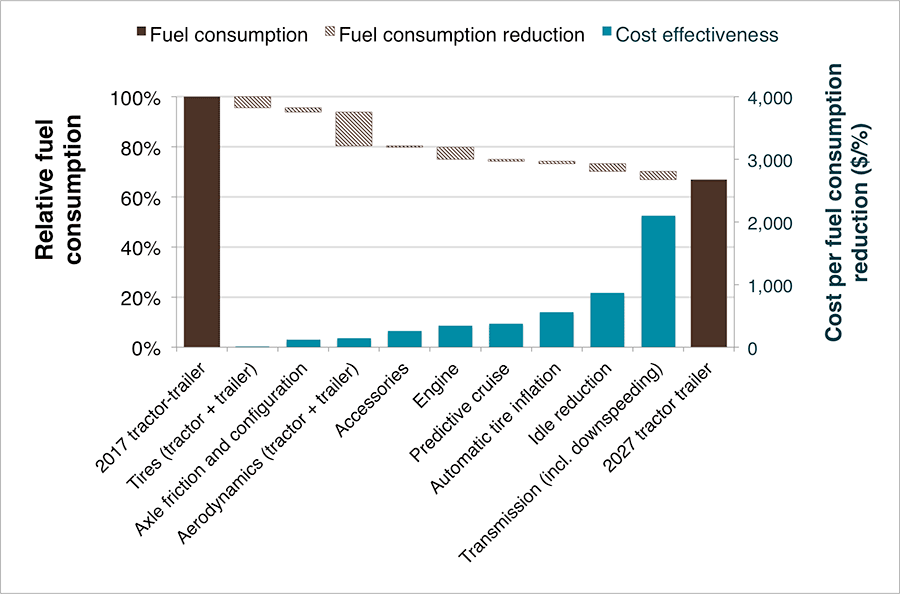Advanced tractor-trailer efficiency technology potential in the 2020–2030 timeframe
Blog
Parsing Phase 2: Tractor-trailers in the proposed regulation
The proposed new “Phase 2” standard for heavy-duty vehicle fuel consumption and GHG emissions in the U.S. is long and complex (find a concise summary here) — not surprising, because the HDV transportation sector is large and complex, with dozens of different vehicle types and a huge variety of operating conditions. One way to begin to cut through the complexity is to look at the vehicle category most of us are most familiar with: tractor-trailers.
The place to start is not with the terms of the rule but with the process. In the end, the stringency of the standard for a vehicle category is what drives efficiency improvements, so setting the stringency level and making sure protocols are in place to properly measure improvements are key. The EPA and NHTSA are required to balance a number of factors, including cost, technological potential, and market acceptance. In addition, the agencies don’t want to be too prescriptive about specific vehicle technologies, so that industry retains the ability to balance regulatory compliance with customer demand. The fact that the rule can prescribe no single technology pathway that all manufacturers will ultimately follow helps explain the methodology of drafting the rule.
In very brief outline: The agencies first determine a starting point, or baseline. For the proposed Phase 2 rule, the baseline year for tractor-trailer and vocational trucks is 2017, where the previous regulation leaves off. Then they forecast the potential for technologies to improve performance over the baseline. This step requires collecting detailed data on all the individual efficiency technologies in the engine, transmission, aerodynamic improvements, and their CO2-reduction effectiveness in various vehicle types. That comes from a combination of lab testing and consultation with vehicle and component manufactures who develop all the technologies. Then the agencies model the technologies to understand how they interact. Lastly, they assess the potential market penetration of each technology in the timeframe of the proposed regulation.
At that point, the agencies are able to forecast how the vehicle fleet as a whole will change over the time period covered by the regulation. That allows them to create a composite of a compliant vehicle for each vehicle segment. The figure below depicts such a composite 2027 tractor-trailer. It shows how a Class 8 high-roof sleeper-cab tractor-trailer combination could reduce its overall fuel consumption by approximately 33% under Phase 2 from 2017 to 2027 (based on ICCT’s analysis of the proposal). Engine, tractor, and trailer technologies are all included, and are presented in the figure in the approximate order of their cost effectiveness (i.e., cost per level of fuel consumption reduction).

Estimated efficiency technology improvements and costs to go from a Phase 1 (2017) tractor trailer to a Phase 2 (2027) Class 8 high roof sleeper tractor-trailer.
Reading the figure from left to right, it’s apparent that low-rolling-resistance tires and improved aerodynamics are among the most cost-effective options in this segment. Automated transmissions and idle-reduction technology are more costly technologies to implement, while improvements to the engine sit in the middle of the range. Although the transmission is less cost-effective considered by itself, according to this analysis, it enables many of the integrated powertrain approaches that are being pursued by manufacturers, and it also is a favorite among many fleets.
Will manufacturers ever produce a single vehicle that combined this exact technology package? No. And that is the beauty of the proposal: aside from certain required reductions coming from the trailer and the engine, it gives manufacturers freedom to determine their own technology pathway. Manufacturers and fleets that prefer engine technologies will do more in that area; others that emphasize drivetrain and aerodynamic improvement for their tractors will do more there. To each his (or her) own, as they say.
The sixty-day public comment period for the proposal opened just over a week ago, and it seems safe to anticipate that many of the comments submitted will argue that the agency either overestimated or underestimated the potential reductions from a given technology. (Hint: some manufacturers will argue “over,” and environmental groups will argue “under.” In fact, our own technology analysis and follow-on cost estimates indicate that there is significantly more potential to improve the efficiency of the engine than what the agencies estimated, but admittedly we didn’t consider all the factors the agencies did.) In the end, though, if new tractor-trailer combinations are getting 33% efficiency improvements in 10 years’ time, most people are going to count that as a win for the environment, consumers, and industry.
